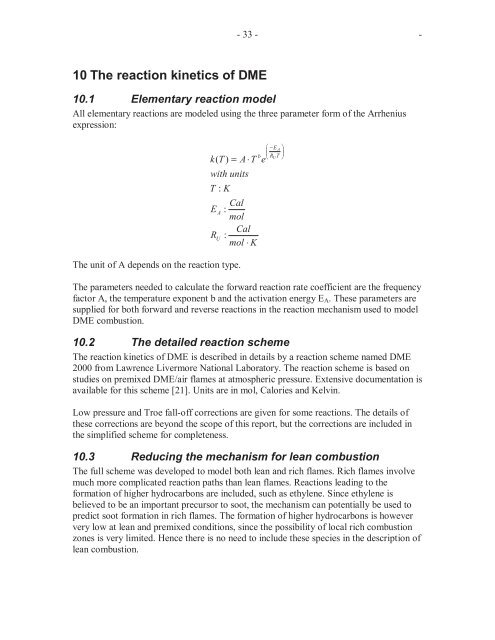Troels Dyhr Pedersen.indd - Solid Mechanics
Troels Dyhr Pedersen.indd - Solid Mechanics
Troels Dyhr Pedersen.indd - Solid Mechanics
Create successful ePaper yourself
Turn your PDF publications into a flip-book with our unique Google optimized e-Paper software.
10 The reaction kinetics of DME<br />
- 33 - -<br />
10.1 Elementary reaction model<br />
All elementary reactions are modeled using the three parameter form of the Arrhenius<br />
expression:<br />
k(<br />
T ) = A ⋅T<br />
e<br />
with units<br />
T : K<br />
Cal<br />
E A :<br />
mol<br />
Cal<br />
RU<br />
:<br />
mol ⋅ K<br />
The unit of A depends on the reaction type.<br />
−E<br />
A <br />
b<br />
<br />
<br />
RU<br />
T <br />
<br />
<br />
The parameters needed to calculate the forward reaction rate coefficient are the frequency<br />
factor A, the temperature exponent b and the activation energy EA. These parameters are<br />
supplied for both forward and reverse reactions in the reaction mechanism used to model<br />
DME combustion.<br />
10.2 The detailed reaction scheme<br />
The reaction kinetics of DME is described in details by a reaction scheme named DME<br />
2000 from Lawrence Livermore National Laboratory. The reaction scheme is based on<br />
studies on premixed DME/air flames at atmospheric pressure. Extensive documentation is<br />
available for this scheme [21]. Units are in mol, Calories and Kelvin.<br />
Low pressure and Troe fall-off corrections are given for some reactions. The details of<br />
these corrections are beyond the scope of this report, but the corrections are included in<br />
the simplified scheme for completeness.<br />
10.3 Reducing the mechanism for lean combustion<br />
The full scheme was developed to model both lean and rich flames. Rich flames involve<br />
much more complicated reaction paths than lean flames. Reactions leading to the<br />
formation of higher hydrocarbons are included, such as ethylene. Since ethylene is<br />
believed to be an important precursor to soot, the mechanism can potentially be used to<br />
predict soot formation in rich flames. The formation of higher hydrocarbons is however<br />
very low at lean and premixed conditions, since the possibility of local rich combustion<br />
zones is very limited. Hence there is no need to include these species in the description of<br />
lean combustion.

















